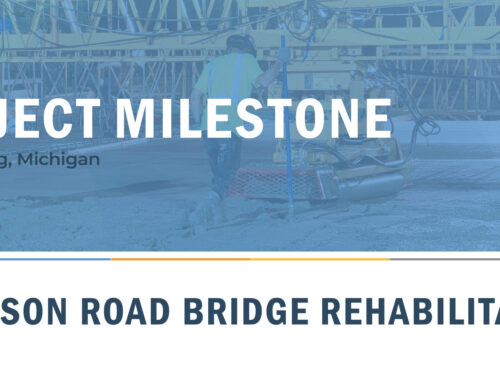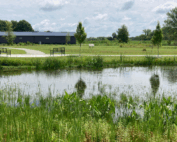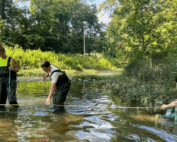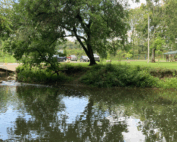Tucked inside Brownsburg’s Arbuckle Acres Park, White Lick Creek is slowly reshaping its own borders: not with heavy machinery, but with the steady force of water. Over time, streambank erosion has eaten away at the land, threatening nearby trails and habitats. This process, called streambank erosion, happens when flowing water gradually removes soil and rock from a river’s edge. If not addressed, it can swallow areas of land, damage nearby infrastructure, and send extra sediment into the stream, harming water quality and aquatic habitats.
In the past, the problem was controlled with riprap, large rocks placed along the banks. Over time, many of these rocks were washed away by storms or moved by park visitors, leaving the streambanks exposed once again.

Stream ingress at White Lick Creek (Area 8).
The White Lick Creek Wetland Creation and Rootwad Bank Stabilization project set out to address these challenges by creating naturally aesthetic ingress points into the creek while stabilizing eroded streambanks. Led by project lead Aaron Barding, PE, along with Cameron Fraser, Alex Douglas, and Brian Powers, PE, CFM, the effort explores innovative ways to protect streambanks while improving ecological function and meeting permitting requirements.
“There’s a lot of erosion occurring on the stream bank, and we are stabilizing that so it doesn’t further erode into the stream and reduces sediment deposition,” Aaron said. “We are trying to go for a more ecosystem-friendly design that supports not only the streambank, but also aquatic life.”
As part of this work, the Indiana Department of Environmental Management (IDEM) required mitigation to offset sediment pollution caused by the eroding banks. The chosen solution was wetland creation, with monitoring over three years. Work began in October 2024, with construction expected to conclude in fall 2025, followed by post-construction monitoring through 2028.

Rootwad at White Lick Creek (Site 2).
“It started because of the mitigation and monitoring that was required by IDEM,” Aaron said. “But in our office, we haven’t done much wetland design or monitoring before. This project was a good opportunity to gain that experience.”
Because of the project’s potential, Aaron brought it to Clark Dietz’s Research & Development (R&D) Committee, which funds innovative ideas that expand the firm’s capabilities. This internal investment positions the team for future environmental work.
This project serves as a testbed for nature-based engineering solutions, moving beyond typical stabilization methods like riprap or 3:1 side slopes. One unique feature is floodplain shelf restoration using rootwads, large tree trunks with roots still attached, placed in the water to reduce the stream’s erosive power and create safe habitats for fish and aquatic life. This stretch of stream includes a near-vertical, 35-foot-tall exposed cliff with a multi-use path along the top, eliminating the option of regrading to a gentler slope. The rootwad alternative reduced what IDEM considers “impact” by 200 feet, lowering overall project costs.

White Lick Creek (Area 11 and 12).
Research & Development Committee
Clark Dietz’s R&D Committee supports projects that foster creativity, experimentation, and practical problem-solving. Its mission is to explore and implement ideas that enhance efficiency, improve client service, and strengthen competitive advantage, demonstrated through its support of the White Lick Creek enhancements.
“The White Lick Creek Wetland Creation and Rootwad Bank Stabilization project is a great example of how Clark Dietz’s Research & Development Program can turn innovative ideas into tangible, lasting impacts,” said Committee Chair Scott Anstandig. “Under Aaron Barding’s leadership, our team is pioneering cost-effective, ecologically sound solutions that not only serve our clients but also strengthen our position for future opportunities. This is exactly the kind of forward-thinking, collaborative work our R&D program is designed to inspire. I encourage every member of our team to share their ideas. Our next success won’t come without new concepts!”
Building on that vision, the R&D Committee seeks out and applies new technologies and approaches that elevate quality, streamline operations, and exceed client expectations. By fostering continuous learning and innovation, the committee helps keep Clark Dietz at the forefront of engineering.

Engineering intern Alexander Lefever completing a pebble count at White Lick Creek (Site 2). Pebble counts are used for stream morphology and scour calculations.
Progress and Milestones
The team’s involvement goes beyond formal design work. They recently completed key stream morphology calculations, a critical milestone in the design process, and collected stream samples as part of a Volunteer Time Off (VTO) day, a program where Clark Dietz pays employees to spend a workday volunteering in their community or in one of the communities we serve.
During the VTO day, team members gathered water samples later tested for phosphorus, nitrogen, E. coli bacteria, turbidity (how much sediment is suspended in the water), pH, dissolved oxygen, and other basic water quality indicators. They also conducted a habitat assessment to evaluate how well the area supports aquatic life.
“It was really good to get people out there and to hear what they said about the site, and to collect those samples so we can do a before-and-after comparison to see if our project has any impacts on the area,” Aaron said.

White Lick Creek water sampling.
Expanding Opportunities
Looking ahead, the White Lick Creek project offers a model for addressing erosion in ways that balance engineering needs with environmental benefits.
“Our approach is about finding solutions that work with nature, not against it,” Aaron said. “By integrating rootwad structures and restoring floodplain shelves, we can stabilize banks and create lasting ecological benefits while meeting regulatory and cost goals.”
Projects like White Lick Creek show that infrastructure improvements can do more than solve immediate problems; they can create healthier ecosystems, stronger communities, and new possibilities for the future.



























